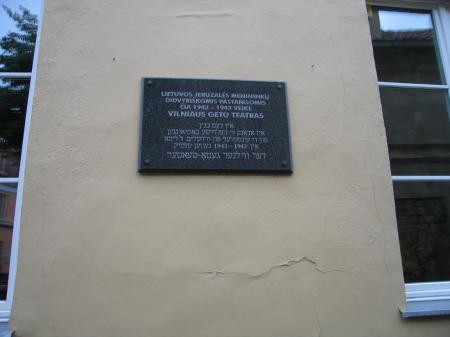Obj. ID: 45471
Modern Jewish Art Memorial Plaque to the Ghetto Theater in Vilnius, Lithuania, 2002

Memorial name
No official name.
Who is Commemorated?
The theater of the Vilnius Ghetto and its actors.
Description:
A gray granite plaque is fixed to the wall of the former ghetto theater, which currently functions as the Lėlė puppet theater. It contains two identical inscriptions in Lithuanian and Yiddish.
Inscriptions:
In Lithuanian:
Lietuvos Jeruzalės menininkų
didvyriškomis pastangomis
čia 1942 – 1943 veikė
Vilniaus geto teatras
Translation: Thanks to heroic efforts of the artists of the Jerusalem of Lithuania, the Vilnius Ghetto Theater operated here from 1942 to 1943.
In Yiddish:
אין דעם בנין
איז אדאנק די העלדישע באמיאונגען
פון די קינסטלער פון ירושלים ד'ליטא
אין 1942 – 1943 געווען טעטיק
דער ווילנער געטאָ-טעאטער
Translation: In this building, thanks to the heroic efforts of the artists from the Jerusalem of Lithuania, the Vilnius Ghetto Theatre operated from 1942 to 1943.
Commissioned by
The Club of Jewish Culture in Vilnius
sub-set tree:
The building at 5 Arklių St. / 8 Rūdninkų St. was built in the 18th century as a palace of the Oginski family. In the 19th century, this wing of the former palace housed the Nobility Assembly. In 1919 it was taken by a workers’ club. In 1931 the auditorium was converted into a concert hall and became known as the New, or Small City, Concert Hall.
Since the Concert Hall was situated within the boundaries of the ghetto, it was used in 1942 and 1943 as the ghetto theater. The entrance to the hall during those years was from the courtyard of 8 Rūdninkų St., through the Judenrat building.
On the initiative of, and with funding from, the Club of Jewish Culture, the plaque was unveiled on April 22, 2002, in the framework of the International Days of Art, dedicated to the 60th anniversary of the ghetto theater. Several ghetto survivors took part in the opening ceremony: the artist Samuel Bak, the composer Alexander Tamir (Volkovysky), Fanya Brantsovskaia (Yokheles), Solomon Develtov, Hasie Shpanerflig (Friedman), Prof. Mark Petuchauskas (the head of the Club of Jewish Culture).
Agranovskii, Genrikh and Irina Guzenberg. Vilnius: Po sledam Litovskogo Ierusalima. Pamiatnye mesta ereiskoi istorii i kul’tury, 2nd ed. (Vilnius: The Vilna Gaon Jewish State Museum, 2016)., p. 192.
Guzenberg, Irina, Vilnius: Traces of the Jewish Jerusalem of Lithuania. Memorable Sites of Jewish History and Culture. A Guidebook (Vilnius: Pavilniai, 2021)., 200.
Guzenberg, Irina. Vilnius: Pamiatnye mesta evreiskoi istorii i kul'tury (Vilnius: Pavilniai, 2013)., 53.







